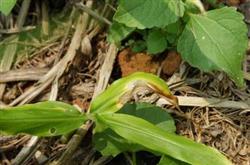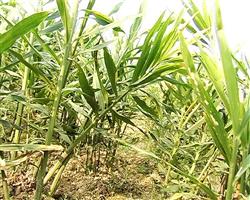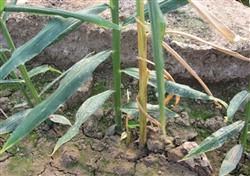Ginger Planting Technology: What is Ginger Blast?

What is ginger plague? Please describe in detail that ginger blast is a bacterial disease caused by Pseudomonas solanacearum. Once the disease occurs in the ginger field, the yield will be reduced if the disease is light, and the yield will be eliminated if it is heavy. In recent years, the disease has become more and more serious year by year, which has become an important reason restricting the production of Zingiber officinale. Through the research and field experiments in recent years, it has been proved that the occurrence and spread of ginger blast can be effectively controlled by comprehensive control measures. 1. Harmful symptoms: ginger blast mainly infects underground stems and roots. after the fleshy stems are damaged, the fleshy stems initially show water collapse, the epidermis becomes yellowish brown, lose luster, and gradually soften and rot from the internal tissue, leaving only the outer skin. Squeeze the diseased part can flow out dirty white rice water-like juice, give off a bad smell. The root was also yellowish brown and gradually rotted. The aboveground stem was dark purple, the internal tissue turned brown and rotted, and only fiber remained. The leaves withered, the leaf margin curled, and the color was yellowish, until the whole plant drooped and died. two。 The long-distance transmission of the pathogenic bacteria mainly depends on the bacteria-carrying ginger species, and the field transmission is usually spread by means of running water, pests, diseased soil and remains carried by agricultural machinery and tools, and agricultural operations. The bacteria-carrying ginger species fell ill during the growth period and became the central disease plant in the field and spread. The disease is easy to occur in high temperature and humid weather, sometimes rain and sometimes sunny weather, especially when the soil temperature changes repeatedly, which is beneficial to the occurrence of the disease. The aboveground part grew poorly, yellowed and withered, and the plant withered with the aggravation of the disease. 3. Integrated control (1) crop rotation: select the land with good soil fertile drainage and irrigation for rotation, once every three years. (2) Ginger seed treatment: before accelerating germination, ginger seeds were soaked in 1 ∶ 1 ∶ Bordeaux solution for 20 minutes, streptomycin sulfate 500ppm for 48 hours or 40% formalin 100 times solution for 6 hours, and the liquid level was higher than ginger 5~10cm. (3) Formula fertilization: re-apply organic fertilizer, increase phosphorus and potassium fertilizer, avoid partial application of nitrogen fertilizer, and promote the use of high-quality farm manure. Soil organic matter content 1%, available nitrogen 80ppm, available phosphorus 50ppm, available potassium 100ppm are suitable. (4) reasonable close planting: about 5500 piers per mu should be planted to prevent overdensity, change the field microclimate, improve the ventilation and light transmission conditions, and reduce the field humidity. Reduce the number of hoes to prevent accidental damage. (5) uprooting diseased plants: the diseased plants in the center of the field shall be eradicated in time and transported to the field for centralized destruction and treatment, and shall not be discarded at will. Around the disease point, 5% blue alum, streptomycin sulfate and other agents are used to fill the disease point or sprinkle it with quicklime, fill the disease point, and build a ridge around the disease point to prevent the disease from spreading by running water. (6) Chemical control: before the arrival of the flood season, the root was irrigated with 1000 times liquid of Kemailing twice with an interval of 15 to 20 days to prevent the occurrence of ginger blast. Spray every 10 days from the beginning of July to the end of August, you can choose 50% nail cream copper 500x liquid, or 1 ∶ 1 ∶ 100Bordeaux liquid, or 75% bacterial net 500x liquid whole plant uniform spray control, with 50ml 75kg per mu, can effectively control the occurrence and spread of ginger blast. Click to get more ginger planting techniques click to get more vegetable planting techniques
- Prev

Ginger planting techniques: how to manage ginger in summer and autumn?
How to manage ginger in summer and autumn? Please give instructions that ginger grows fastest in summer and autumn, has the greatest impact on yield components, and is most seriously affected by diseases and insect pests, especially ginger blast, which will cause plant death and ginger block rot, resulting in reduced yield. Therefore, it is necessary to strengthen the management of ginger in summer and autumn to ensure the normal growth of ginger.
- Next

Ginger planting techniques: what is Dioscorea zingiberensis stem rot?
What is turmeric stem rot? Please introduce and control methods: turmeric stem rot is a fungal disease caused by Fusarium oxysporum. The fungus is saprophytic for a long time in the soil and spreads through water flow and tillage, through rhizome wounds or directly from branch cracks and the base of aged seedling stems.
Related
- Where is it suitable to grow horseradish in China? it is expected to see the middle altitude horseradish in Alishan.
- How to prevent tomato virus disease reasonably? (Control methods included)
- Many people like to plant towel gourd on the balcony. What are the main points of this method and management?
- What crops can chili peppers be mixed with?
- Fertilization techniques and matters needing attention in Tomato
- What are the grafting techniques for peach seedlings in spring?
- Harm and control methods of root swelling disease of Chinese cabbage
- What are the pests of sweet potatoes? How to prevent and cure it?
- Symptoms, causes and Control methods of navel Rot in Tomato
- The cause of "Cucumber rotten bibcock" in Farmers' planting Cucumber and its Control Plan

